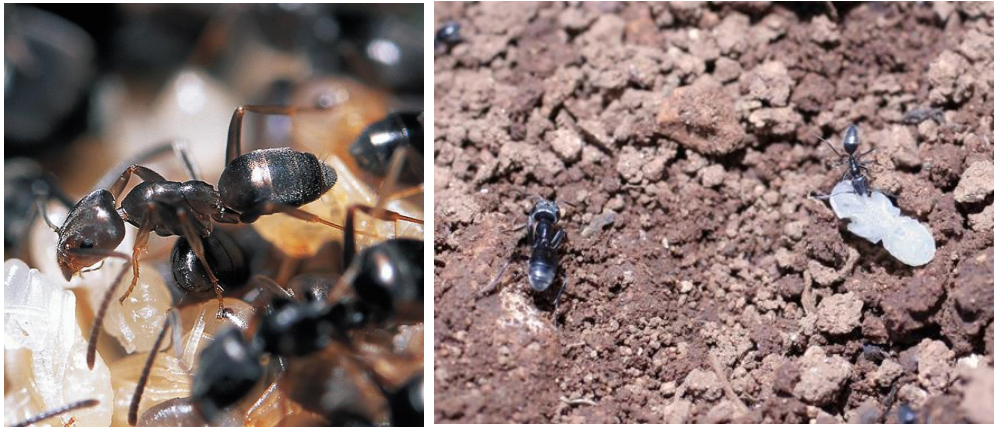Ants help to suppress olive moth infestations
Beyond the results obtained for the Tapinoma ibericum species, the methodology is transferable to the ecology of other omnivorous insects worldwide

Ants are essential species for maintaining the functionality of soil ecosystems, capable of shifting their role in the food web based on the characteristics of each location. Recently, researchers from the National Museum of Natural Sciences (MNCN-CSIC), Doñana Biological Station (EBD-CSIC), and the University of Granada established the specific role of the ant species, Tapinoma ibericum, within the food web of olive grove soils. They specifically analyzed its role in controlling the olive moth, confirming that it can help manage this pest.
The results, published in the Journal of Applied Entomology, show that this ant species can be used for pest control in these cultivated areas without posing a risk to other species in the soil community. Furthermore, based on the information gathered, the employed methodology has been proposed as a new, useful method for trophic analysis in other communities of ants and omnivorous insects.
But, how have they analyzed the role that ants can play in the control of pests in agricultural ecosystems? Through the analysis of stable isotopes in the tissues of ant populations. This analysis allows us to know the changes in the diet of these ants depending on the habitat and conditions of each population. "We compared the changes in their diet in experiments where food was made available to them, forcing them to act as herbivores, predators, and hyper-predators. In turn, these results were compared with the natural diet in cultivated areas subjected to different agricultural managements," clarifies MNCN researcher Hugo Alejandro Álvarez. "The results obtained confirm that this ant species does not behave as a hyper-predator—that is, it does not end up becoming a threat to other pest-predatory species—but rather that its predatory activity is limited to the effects produced on the pest, thus limiting the pest's population growth and its effect on the crop. Furthermore, we have confirmed that the isotopes do not vary significantly depending on the agricultural management of each crop and that their diet adapts to the resources available in each habitat," continues Álvarez.
"Ants are opportunistic, and if pests like the olive moth (Prays oleae) are present, the ants will feed on them. The added confirmation that they do not turn into hyper-predators —which could pose a problem for other species necessary to maintain the health of the soil and the olive tree itself— makes them ideal candidates to act in the control of this type of pest," notes researcher Francisca Ruano from the University of Granada.
A novel methodologhy
Beyond the study's specific findings, this research proposes a new technique applicable to analyzing and studying other species that could potentially control insect and organism pests—a growing problem for agricultural crops. This novel technique involves the analysis of stable isotopes in dietary experiments.
Isotopes are atoms with the same number of protons but a different number of neutrons; they're called stable because they aren't radioactive, allowing many of them to accumulate in living tissues. Stable isotope analysis commonly uses Nitrogen-15 (15N) and Carbon-13 (13C). These two isotopes become enriched in tissues relative to an organism's diet because lighter isotopes—such as Carbon-12 (12C) being lost through respiration and Nitrogen-14 (14N) through urinary excretion—are eliminated. While analyzing this "isotopic signature" provides significant information about an organism’s diet and position in the food web, using only this signature is often insufficient for groups like ants and other omnivores due to their shifting diets. Therefore, subjecting study individuals to different experimental diets (e.g., plant vs. animal) makes it possible to detect the point at which the isotopic signature changes or stabilizes over time, establishing the population's trophic profile in the lab. Once this baseline is confirmed, it can be compared to the signature of field populations to accurately trace their trophic role. "These two simple, yet novel, steps make this methodology a successful experimental research protocol within community ecology that can be replicated and used for any organism on the planet," confirms Álvarez.
The group of species studied from the genus Tapinoma, specifically the Tapinoma nigerrimum complex, was previously considered detrimental to European agriculture. However, this study shows the opposite for the Iberian species. "Undoubtedly, this research can help those who work with agricultural ecosystems, such as farmers and technicians, when it comes to implementing biological pest control in both olive cultivation and other plantations," concludes EBD researcher Rubén Martínez-Blázquez.
Reference:
H. Álvarez, A. García García, Pl Sandoval, R. Martín-Blaquez, B. Seifert, A. Tinaut y F. Ruano. (2023) Elucidating the thropic role of Tapinomia ibericum (Hymenopte4ra:Formicidae) as a potential predator or olvie pests. Journal of Aplied Entomology. DOI: 10.1111/jen.13160